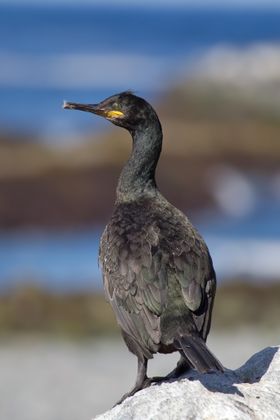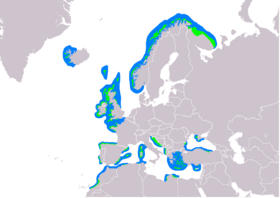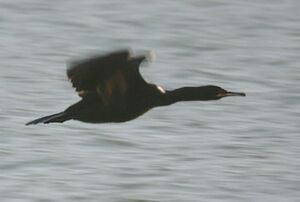غاق شائع
|
غاق شائع | |
|---|---|
 European shag on a rock | |
| حالة الحفظ | |
 أنواع غير مهددة أو خطر انقراض ضعيف جدا | |
| المرتبة التصنيفية | نوع[1] |
| التصنيف العلمي | |
| المملكة: | |
| الشعبة: | الحبليات Chordata
|
| الطائفة: | الطيور Aves
|
| الطويئفة: | طيور حديثة Neornithes
|
| الرتبة العليا: | حديثات الفك Neognathae
|
| الرتبة: | بجعيات Pelecaniformes
|
| الفصيلة: | غاقيات Phalacrocoracidae
|
| الجنس: | غاق Phalacrocorax
|
| النوع: | غاق شائع
|
| الاسم العلمي | |
| Phalacrocorax aristotelis [1] (Linnaeus, 1761)، 1761 | |
 Range of G. aristotelis Breeding Non-breeding | |
| تعديل |
|
غاق شائع (الاسم العلمي:Phalacrocorax aristotelis) هو نوع من الطيور يتبع جنس الغاق من الفصيلة الغاقيات.[2] It breeds around the rocky coasts of western and southern Europe, southwest Asia and north Africa, mainly wintering in its breeding range except for the northernmost birds. In Britain this seabird is usually referred to as simply the shag.[3] The scientific genus name derives from the Latin for glutton. The species name aristotelis commemorates the Greek philosopher Aristotle.[4]
التبويب
The European shag was formerly classified within the genus Phalacrocorax, but a 2014 study found it to be significantly more diverged than the clade containing Phalacrocorax and Urile, but basal to the clade containing Nannopterum and Leucocarbo, and thus classified it in its own genus, Gulosus.[5] The IOC followed this classification in 2021.[6] Gulosus is thought to have split from the Nannopterum-Leucocarbo clade between 9.0 - 11.2 million years ago.[5]
الأنواع الفرعية
There are three subspecies:[7]
- G. a. aristotelis – (Linnaeus, 1761): nominate, found in northwestern Europe (Atlantic Ocean coasts)
- G. a. desmarestii – (Payraudeau, 1826): found in southern Europe, southwest Asia (Mediterranean and Black Sea coasts)
- G. a. riggenbachi – Hartert, 1923: found in northwest African coast
The subspecies differ slightly in bill size and the breast and leg colour of young birds. Recent evidence suggests that birds on the Atlantic coast of southwest Europe are distinct from all three, and may be an as-yet undescribed subspecies.[8]
The name shag is also used in the Southern Hemisphere for several additional species of cormorants.
الوصف
هو بحجم الإوزة(90 سم) لون ريش الطيور البالغة أسود مع لمعان أخضر، الذقن أبيض وكذلك الوجنتان، والطيور الموجودة في العالم القديم عارية الحنجرة صفراء اللون. بينما الطيور الصغيرة بنية اللون مع بطن أبيض. It has a longish tail and yellow throat-patch. Adults have a small crest in the breeding season. It is distinguished from the great cormorant by its smaller size, lighter build, thinner bill, and, in breeding adults, by the crest and metallic green-tinged sheen on the feathers. Among those differences are that a shag has a lighter, narrower beak; and the juvenile shag has darker underparts. The European shag's tail has 12 feathers, the great cormorant's 14 feathers. The green sheen on the feathers results in the alternative name green cormorant sometimes being given to the European shag.
علم الأحياء
It feeds in the sea, and, unlike the great cormorant, is rare inland. It will winter along any coast that is well-supplied with fish. The European shag is one of the deepest divers among the cormorant family. Using depth gauges, European shags recorded diving up to 61 m (200 ft) deep.[9] European shags are preponderantly benthic zone feeders, i.e. they find their prey on the sea bottom. They will eat a wide range of fish but their commonest prey is the sand eel. Shags will travel many kilometres from their roosting sites in order to feed.
In UK coastal waters, dive times are typically around 20 to 45 seconds, with a recovery time of around 15 seconds between dives; this is consistent with aerobic diving, i.e. the bird depends on the oxygen in its lungs and dissolved in its bloodstream during the dive. When they dive, they jump out of the water first to give extra impetus to the dive.
It breeds on coasts, nesting on rocky ledges or in crevices or small caves. The nests are untidy heaps of rotting seaweed or twigs cemented together by the bird's own guano. The nesting season is long, beginning in late February but some nests are not started until May or even later. Three eggs are laid. Their chicks hatch without down and so they rely totally on their parents for warmth, often for a period of two months before they can fly. Fledging may occur at any time from early June to late August, exceptionally to mid-October.
الطعام
The shag is a pursuit-diving seabird that feeds predominantly in benthic habitats. Due to the relative ease with which diet samples can be collected from this species (regurgitated food or pellets) and the perceived conflict between the Phalacrocoracidae and fisheries, shag diet competition has been the subject of substantial scientific interest.[10][11][12][13] Evidence collected at one colony, the Isle of May, Scotland, between 1985 and 2014, suggests that shag chick diet composition in this population has diversified in response to ocean warming.[14] Shags also feed on fewer sandeel on windy days, presumably due to the strong effect of wind on flight in this species.[15] The year-round diet of full-grown shags at this colony has also changed over the past 3 decades, from sandeel specialists to an increasingly diverse prey base.[16]
التوزع
يوجد في أوروبا وآسيا وأفريقيا وشمال شرقي كندا، وفي الشتاء في الولايات الأمريكية الوسطى الواقعة على الأطلسي.
The largest colony of European shags is in the Cíes Islands, Spain, with 2,500 pairs (25% of the world's population).
معرض صور
Composite image of the bird jumping into the sea in Malinska, Croatia
Eggs, Collection Museum Wiesbaden
Young European shag in Croatia
انظر أيضاً
مراجع
- ^ أ ب ت ث ج Imported from Wikidata item: https://www.wikidata.org/wiki/Q115452
- ^ Kennedy, Martyn; Spencer, Hamish G. (2014-10-01). "Classification of the cormorants of the world". Molecular Phylogenetics and Evolution (in الإنجليزية). 79: 249–257. doi:10.1016/j.ympev.2014.06.020. ISSN 1055-7903. PMID 24994028.
- ^ خطأ استشهاد: وسم
<ref>غير صحيح؛ لا نص تم توفيره للمراجع المسماةoceanwanderers - ^ Jobling, James A (2010). The Helm Dictionary of Scientific Bird Names. London: Christopher Helm. pp. 55, 301. ISBN 978-1-4081-2501-4.
- ^ أ ب Kennedy, Martyn; Spencer, Hamish G. (2014-10-01). "Classification of the cormorants of the world". Molecular Phylogenetics and Evolution (in الإنجليزية). 79: 249–257. doi:10.1016/j.ympev.2014.06.020. ISSN 1055-7903.
- ^ "Taxonomic Updates – IOC World Bird List" (in الإنجليزية الأمريكية). Retrieved 2021-07-28.
- ^ خطأ استشهاد: وسم
<ref>غير صحيح؛ لا نص تم توفيره للمراجع المسماةIOC - ^ خطأ استشهاد: وسم
<ref>غير صحيح؛ لا نص تم توفيره للمراجع المسماةYesou - ^ "species". polaris.nipr.ac.jp. Retrieved 2022-08-10.
- ^ Snow, Barbara (1960-10-01). "The Breeding Biology of the Shag Phalacrocorax Aristotelis on the Island of Lundy, Bristol Channel". Ibis (in الإنجليزية). 102 (4): 554–575. doi:10.1111/j.1474-919x.1960.tb07132.x. ISSN 1474-919X.
- ^ Barrett, RT; Rov, N; Loen, J; Montevecchi, WA (1990). "Diets of shags Phalacrocorax aristotelis and cormorants P carbo in Norway and possible implications for gadoid stock recruitment" (PDF). Marine Ecology Progress Series. 66: 205–218. Bibcode:1990MEPS...66..205B. doi:10.3354/meps066205.
- ^ Harris, M. P.; Wanless, S. (1991). "The Importance of the Lesser Sandeel Ammodytes marinus in the Diet of the Shag Phalacrocorax aristotelis". Ornis Scandinavica (Scandinavian Journal of Ornithology). 22 (4): 375–382. doi:10.2307/3676511. JSTOR 3676511.
- ^ Cosolo, Mauro; Privileggi, Nicoletta; Cimador, Barbara; Sponza, Stefano (2011-11-01). "Dietary changes of Mediterranean Shags Phalacrocorax aristotelis desmarestii between the breeding and post-breeding seasons in the upper Adriatic Sea". Bird Study. 58 (4): 461–472. doi:10.1080/00063657.2011.603290. ISSN 0006-3657. S2CID 59032510.
- ^ Howells, RJ; Burthe, SJ; Green, JA; Harris, MP; Newell, MA; Butler, A; Johns, DG; Carnell, EJ; Wanless, S (2017). "From days to decades: short- and long-term variation in environmental conditions affect offspring diet composition of a marine top predator". Marine Ecology Progress Series (in الإنجليزية). 583: 227–242. Bibcode:2017MEPS..583..227H. doi:10.3354/meps12343.
- ^ Lewis, Sue; Phillips, Richard A.; Burthe, Sarah J.; Wanless, Sarah; Daunt, Francis (2015-11-01). "Contrasting responses of male and female foraging effort to year-round wind conditions". Journal of Animal Ecology (in الإنجليزية). 84 (6): 1490–1496. doi:10.1111/1365-2656.12419. ISSN 1365-2656. PMC 4989534. PMID 26283625.
- ^ Howells, Richard J.; Burthe, Sarah J.; Green, Jonathan A.; Harris, Michael P.; Newell, Mark A.; Butler, Adam; Wanless, Sarah; Daunt, Francis (2018-11-21). "Pronounced long-term trends in year-round diet composition of the European shag Phalacrocorax aristotelis". Marine Biology (in الإنجليزية). 165 (12). doi:10.1007/s00227-018-3433-9. ISSN 0025-3162.
موسوعة الطيور المصورة.
- CS1 الإنجليزية الأمريكية-language sources (en-us)
- Short description is different from Wikidata
- أنواع القائمة الحمراء غير المهددة
- حالة حفظ مختلفة عن ويكي بيانات
- صفحات بها بيانات ويكي بيانات
- صفحات بها مراجع ويكي بيانات
- صفحات تستخدم خاصية P105
- تسمية علمية same as Wikidata
- صفحات تستخدم خاصية P935
- بذرة طيور
- طيور جزر فارو
- طيور أوروپا
- طيور الصحراء الغربية
- غاق
- طيور كازاخستان
- طيور تركيا
- غاقيات
- أنواع الطيور
- طيور آسيا
- طيور أفريقيا
- طيور أمريكا الشمالية






